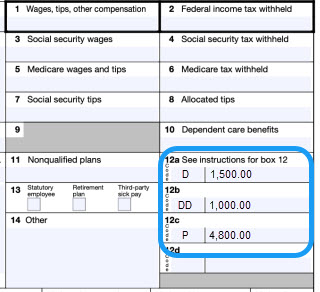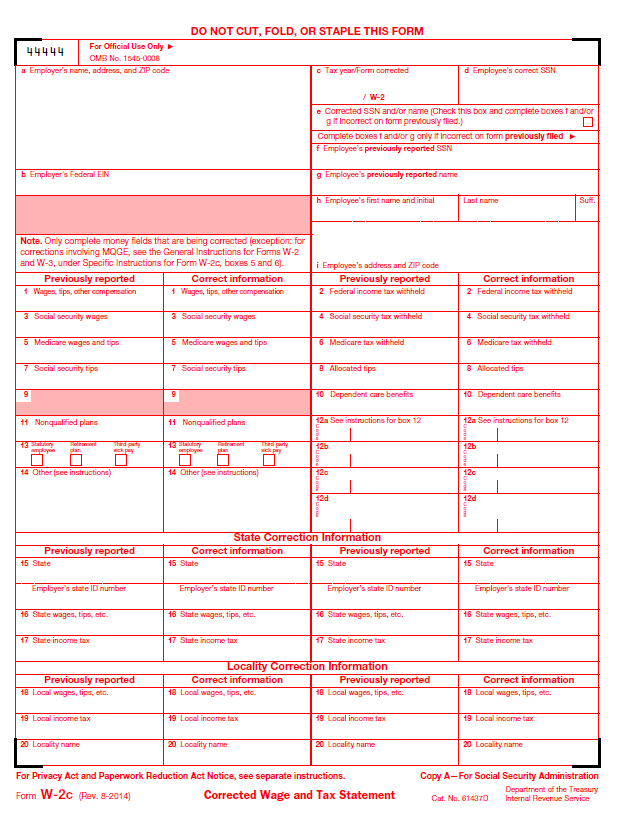
Payroll and HR managers work hard to produce accurate Form W-2s. However, even thorough efforts can raise questions and bring potential problems to light. Mistakes happen to the best of us, and it’s not always easy to avoid W-2 errors.
So what do you do when an error occurs on an employee’s Form W-2 Wage and Tax Statement? Better yet, how can you avoid these errors in the first place?
This article lists the top ten most common Form W-2 errors and how to fix them to avoid potential fines today.
Understanding Common W-2 Errors
W-2 errors are more common than most people think. These mistakes can have serious consequences, from incorrect employee information to calculating contributions. Inaccurate W-2 forms can result in costly penalties, employee dissatisfaction, and IRS audits.
Therefore, it is crucial for payroll and HR professionals to understand the most frequent W-2 errors and how to prevent them. Even small mistakes can lead to significant consequences, making vigilance essential.
Common Errors on Form W-2
Can you report an error on a W-2? Yes, you can, and you should, in order to avoid any potential fines or penalties. Below, we outline some common errors found on W-2s and how to correct them.
1. Excess Contributions to a Health Savings Account
What do you do if you make excess contributions to an employee’s Health Savings Account (HSA)? Excess contributions are any amount that exceeds the 2021 maximum of $3,600 for self-only coverage or $7,200 for family coverage. You can correct excess contributions in the following ways:
- Request that the financial institution return excess funds to the employee. Then, a Form W-2c Corrected Wage and Tax Statements will be issued showing the reduced amount reported in box 12 Code W.
- If you choose not to recover the excess contributions, report those funds as taxable wages on Form W-2 boxes 1, 3, and 5. Boxes 4 and 6 show the Social Security and Medicare tax owed on the excess amount. If this is not recorded correctly on Form W-2, then a W-2c form must be issued.
Form W-2: Box 12, Code DD Information
A common question is, “What is Code DD on Form W-2?” Employers use this code in Box 12 of Form W-2 to report the actual amount of an employee’s health care benefits.
This reported amount generally includes the portions paid by the employer and the employee. However, it doesn’t include any salary reduction contributions. The amount recorded for Code DD is not taxable and is for information purposes.

Not sure what to report on Box 12?
Click here to find out!
2. Excess Contributions to Qualified Retirement Plan
Qualified retirement plans include 401(k) and 403(b) plans. Excess contributions are reported on Form 1099-R. The employee is responsible for communicating with their trust plan administrator to make a corrective distribution.
Note: Remind employees that for a trust or estate with a tax year ending December 31, the due date for plan administrators to make adjustments is April 15 of the following year.
3. Excess Contributions to a Flexible Spending Account
Here’s what to do if an employee’s pretax contributions exceed the current year’s FSA limit. Refund the excess amount to the employee and the amount recorded as taxable wages in Form W-2c boxes 1, 2, and 5.
The employer is liable for any Social Security and Medicare tax not withheld and must pay the employer portion to the IRS. Organizations are also responsible for any federal income tax and Additional Medicare Tax not withheld. Employers can reduce their federal income and Additional Medicare Tax liability by utilizing Form 4669.
Employees fill out this form to report on tax payments made. Employers use the form to show they are entitled to relief from the liability for the Additional Medicare Tax and federal income tax, not the penalties.
4. Excess Contributions to a Dependent Care Assistance FSA
The American Rescue Plan Act raised the pre-tax contribution limits for dependent care flexible spending accounts (FSAs). The contribution limits are $5,000 per household, while married individuals filing separately can contribute up to $2,500.
If an employee’s contribution exceeds these amounts, it must be subject to FIT, FITW, FICA, and FUTA. Employers must also refund the excess to the employee and the amount reflected as taxable wages in Form W-2c, boxes 1, 3, and 5. There must also be an entry in Form W-2c, box 10, reflecting the employee’s decrease for the amount refunded.
Employers are liable for any FICA taxes withheld, federal income tax, and Additional Medicare Tax. They are also responsible for paying the excess amount to the IRS. Liabilities for the Additional Medicare Tax and federal income, not the penalties, can be subsidized by obtaining Form 4669 from the employee. To obtain Form 4669 from the employee, you need to request that they fill out the form and provide it to you for submission to the IRS.
5. Missing or Incorrect Name or Social Security Number
The IRS requires employers to correct errors in an employee’s name or Social Security number (SSN). Errors include:
- Leaving an employee’s name blank
- Leaving an SSN blank
- Showing the SSN as “000-00-0000”
- Showing the SSN as “applied for” after receiving a valid SSN from the employee.
Employees who have changed their name because of marriage or divorce must furnish a new Form W-4. If the employee’s last name on Form W-4 differs from their Social Security card, they must check box 4 on Form W-4. Failure to correct these errors can lead to penalties and can also result in the IRS rejecting the employee’s tax return.
The method for correcting these errors depends on the circumstances:
| Type of Error | Correction to Form W-2c | Correction to Form W-3c |
|---|---|---|
| An employee incorrectly reported a name or SSN on Form W-2. | Complete boxes d-i for up to the statute of limitations. Tell the employee to correct the Form W-2 attached to Form 1040. | Complete boxes d-j for at least up to the statute of limitations. |
| Employee obtains a new or reissued Social Security card. | Complete boxes d-i only for the most current year. | Complete boxes d-j only for the most current year. |
| Name and SSN were blank on Form W-2. | Call the Social Security Administration for instructions. | Call the Social Security Administration for instructions. |
Error Alert!
The IRS requires that employee Form W-2s and Form 1095-Cs match what’s on their social security cards. For example, if an employee has a hyphenated last name on their social security card but not on their Form W-2 or Form 1095-C, this is considered an error. The penalty for an incorrect W-2 can be significant, especially if it involves a wrong Social Security number.
6. Incorrect Employer Name or Address
An employer’s name and address should be the same across all tax forms. These include forms W-2, 941, 941-SS, 943, 944, CT-1, or Schedule H (Form 1040 or Form 1040-X if the employee needs to correct their 1040). If an employer needs to change their address, they must obtain and file Form 8822-B with the IRS. Form W-3c cannot correct this type of information.
If the only error on Form W-2 is the employee’s address, the employer has three options for correcting the error:
- Give the employee a corrected Form W-2 with a “reissued statement” printed on it.
- Mail the original Form W-2 to the employee’s correct address.
- Give the employee a Form W-2c showing the correct address and all other correct information. See number 5 above for how to correct an incorrect employee name on Form W-2.
Note: Employers should only file Form W-3c with the SSA if they are correcting other errors on Form W-2.
7. Incorrect Reduction in Federal Income Tax Withholding in Connection With a Gross-Up After the Tax Year Closes
According to the IRS Chief Counsel Advice (CCA), a prior year gross-up of income tax represents tax withheld even if the employer paid the tax on behalf of the employee through the gross-up. The CCA also states that employers can’t claim refunds above federal income tax withholdings remitted in a prior calendar year because of a gross-up.
The CCA advises that any federal income tax refund must be claimed on employees’ federal individual income tax returns as reflected in the instructions on Form 941-X.
8. Incorrect EIN or Tax Year
Employer Identification Number (EIN) or tax year errors on Form W-2 can create several time-consuming problems for employers, including issues with Form 941. As a result, a penalty is assessed for EIN and tax year reporting errors. To avoid this penalty, you must correct your EIN or tax year. Correcting the EIN or tax year is a two-step process.
Step 1: Prepare Forms W-2c and W-3c with the Previously Reported Information
- Provide the incorrect EIN in box b or the incorrect tax year in box c.
- Show the money amounts reported initially in the previously reported column.
- Show zeros in the corrected amounts column.
Step 2: Prepare Forms W-2c and W-3c with the Correct Information
- Provide the correct EIN in box b or the incorrect tax year in box c.
Show zero in the money amounts of the previously reported column.
Show the money amounts reported initially in the corrected amounts column.
Ensure employees receive a copy of Forms W-2c and W-3c and file them with the Social Security Administration (SSA).
Wage and Tax Statement Form W-2c

9. Error Withholding Federal Income Tax or Additional Medicare Tax
The IRS does not allow you to correct reporting of federal income tax or Additional Medicare Tax withheld on a Form W-2 from previous years unless it’s “administrative.” If the amounts shown on Form 941 don’t match the organization’s withholding, that’s an administrative error. Because it’s administrative, the organization can correct the error.
The IRS does not allow an employee to have federal income tax or Additional Medicare Tax withheld from current employee wages to correct under- or over-withholding in a previous tax year.
Example 1
Julie, an employee at Stan’s Shoes, noticed her federal income tax withholding was $200 less than her liability. To avoid IRS penalties, she requested that Stan’s Shoes withhold an extra $200 from her current wages.
However, the correction is not an administrative error and cannot be made on a Form W-2c. It must be applied to the current year’s Form W-2.
Example 2
Stan’s Shoes discovered this year that it withheld $75 in Federal income tax from a bonus paid to an employee last tax year, but it failed to include the $75 in box 2 of Form W-2.
Stan’s Shoes may issue a Form W-2c for the previous tax year reflecting the additional $75 in box 2 because this is an administrative error.
10. Excess Social Security or Medicare Tax Withholding
You might be wondering if you’re required to correct a Form W-2 that shows excess FICA withholding or if the employee can request a refund of the excess FICA directly from the IRS. The IRS expects employers to refund any excess FICA withheld on behalf of an employee. Employers need to issue Form W-2c showing the correct FICA withholding.
When you refund FICA tax overpayments to the employee, ensure you receive certification that the employee has not and will not claim a refund of the excess contributions on their income tax return. Once you receive this certification, you may file your tax Form 941-X with the IRS, requesting an adjustment or refund for the employee and employer overpayment of Social Security and Medicare.
Form W-2 Penalties
The Internal Revenue Service (IRS) may impose a penalty for each Form W-2 with a missing or incorrect Social Security number or employee name. If there are W2 errors, you will then be subject to the following penalties:
- $60 per Form W-2 if you correctly file within 30 days of the due date; the maximum penalty is $664,500 per year ($232,500 for small businesses).
- $130 per Form W-2 if you correctly file more than 30 days after the due date but by August 1; the maximum penalty is $1,993,500 per year ($664,500 for small businesses).
- $330 per Form W-2 if you file after August 1, do not file corrections, or do not file required Forms W-2; the maximum penalty is $3,987,000 per year ($1,329,000 for small businesses).
The penalty for an incorrect W-2, especially one involving a wrong Social Security number, can be significant. Additionally, the penalty for the wrong social security number on W-2 forms can lead to costly fines and a time-consuming process to correct.
Form W-2 Frequently Asked Questions:
How long does an employer have to correct an error on Form W-2?
Employers must promptly rectify any mistakes on Forms W-2. The penalty for submitting an inaccurate W-2 to the SSA escalates as time passes. Refer below for further details regarding the penalties associated with this matter.
Do small-dollar de minimis errors need to be corrected?
A de minimis error safe harbor forgives small mistakes under $100 for information reporting and $25 for withholding taxes. Employees can request a corrected Form W-2 (Form W-2c) for small errors. Employers are required to inform employees about this option. As explained in IRS guidance, employers cannot simply disregard small-dollar errors. (Notice 2017-09)
The IRS does not make employers pay back employees for expenses caused by mistakes on Form W-2. Employees may find other avenues for seeking financial restitution.
What are the procedures for issuing a replacement Form W-2?
Employers have the option to provide employees with a new Form W-2. They can use either the official IRS form or an approved substitute. The substitute must adhere to the rules outlined in IRS Publication 1141. The deadline for providing federal Forms W-2 to employees applies only to the original issuance.
What is the procedure when Box 13 “Retirement Plan” is checked in error?
Employers must fix this error as soon as they find it. If box 13 is mistakenly checked for “retirement plan,” the employee may receive IRS notices for more taxes.
To correct the mistake, use Form W-3c. Check box 13 for the retirement plan in the original column. Leave it blank in the corrected column.
When Should You Check Box 13?
- Defined benefit plan (i.e., traditional pension plan): Check the box if employees qualify for employer funding into the plan due to age or years of service, even if the employee may not be vested or ever collect benefits.
- Defined contribution plan (401(k) or 403(b) plan, Roth 401(k) or 403(b) account, but not a 457 plan):
- Do not check the box if an employee is eligible to contribute but does not elect to contribute any money in this tax year.
- Check the box if the employee is eligible to contribute and elects to contribute money in this tax year.
- Check the box if an employee is eligible to contribute but does not elect to contribute any money in this tax year, and the employer does contribute funds.
- Defined contribution plan (401(k) or 403(b) plan, a Roth 401(k) or 403(b) account, but not a 457 plan):
- Do not check the box if an employee has contributed in past years but not during the current tax year, underreport, even if the account value grows due to gains in the investments.
- Profit-sharing plan:
- Check the box if the plan includes a grace period after the close of the plan year when profit sharing can be added to the participant’s account.
Is there an incorrect W-2 penalty?
Yes, there is a penalty for submitting an incorrect W-2, starting at $60 per form. The IRS can impose fines for errors on Form W-2. These errors include incorrect employee information, Social Security numbers, and wage and tax details. The penalties vary based on how quickly the errors are corrected after the filing deadline.
Is there a penalty for the wrong Social Security number on a W-2?
Yes, there is a penalty for submitting a W-2 with an incorrect Social Security number, starting at $60 per form. The IRS requires that the Social Security number on a W-2 match the one on the employee’s Social Security card.
Proactively Handle W-2 Errors
Year-end processing is already overwhelming for most payroll and HR professionals. A unified payroll and HR solution can help you proactively handle W-2 errors to avoid extra stress during this time of year. Here are a few benefits of using an all-in-one payroll and HR platform:
- Enter information only once, eliminating the potential for errors.
- Data syncs between payroll, HR, attendance, and more, so information is always accurate and up-to-date.
- A cloud-based solution provides a secure, centralized database to store and protect sensitive data.
Some payroll providers offer a W-2 error-checking algorithm. This tool can be a significant timesaver, especially during year-end processing. It provides a powerful and intuitive engine that checks your W-2 information against the federal database, alerting you to potential errors before they reach your employees. Remember, a proactive approach is always better than a reactive one.
How APS Can Help You Avoid W-2 Errors
At APS, we’re passionate about making payroll and HR easier for our clients. Our unified solution helps you avoid W-2 errors in the following ways:
- Review, edit, and approve W-2s to ensure you meet filing and distribution deadlines.
- Correct information such as Social Security numbers, employee information, and Box 12 for code DD.
- Access additional year-end resources and information for a smoother process.
Please reach out to us today to learn more about how APS can help you with your W-2s and year-end processing.
The Importance of Accuracy in W-2 Forms
Now is the time to address gaps in your W-2 or year-end processing instead of dealing with penalties later. The potential costs of W-2 errors and incorrect W-2 penalties can be substantial, but adopting a proactive approach and leveraging tools like APS Payroll’s error-checking algorithm can help mitigate these risks.
Accuracy in W-2 forms is not just about compliance; it’s about protecting your organization from unnecessary financial strain and ensuring employee satisfaction. If your current payroll provider doesn’t offer tools like an error-checking algorithm for accurate processing when filing W-2 forms, it may be time for something better.
Sources
About Form W-2 C, Corrected Wage and Tax Statements
About Form W-3 C, Transmittal of Corrected Wage and Tax Statements
About Form W-4, Employee’s Withholding Certificate
About Form 1099-R, Distributions From Pensions, Annuities, Retirement or Profit-Sharing
About Form 941-X, Adjusted Employer’s Quarterly Federal Tax Return or Claim for Refund
Employer-Provided Health Coverage Informational Reporting Requirements: Questions and Answers
Ernst & Young: When, Why and How to Correct Form W-2 Errors
Form 4669, Statement of Payments Received











